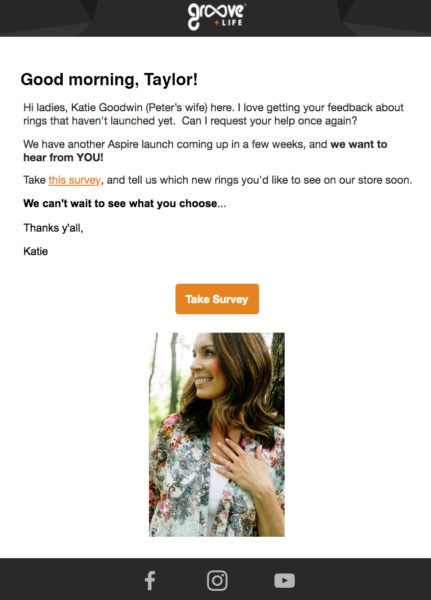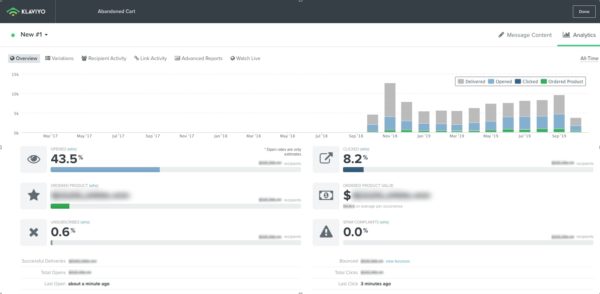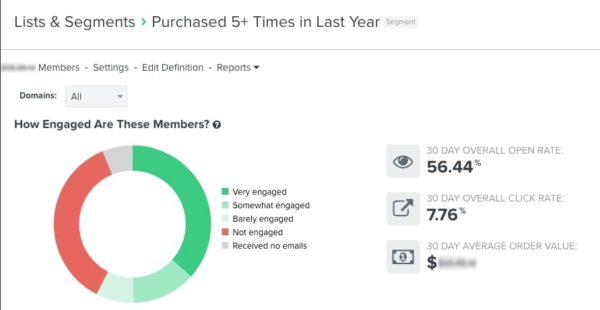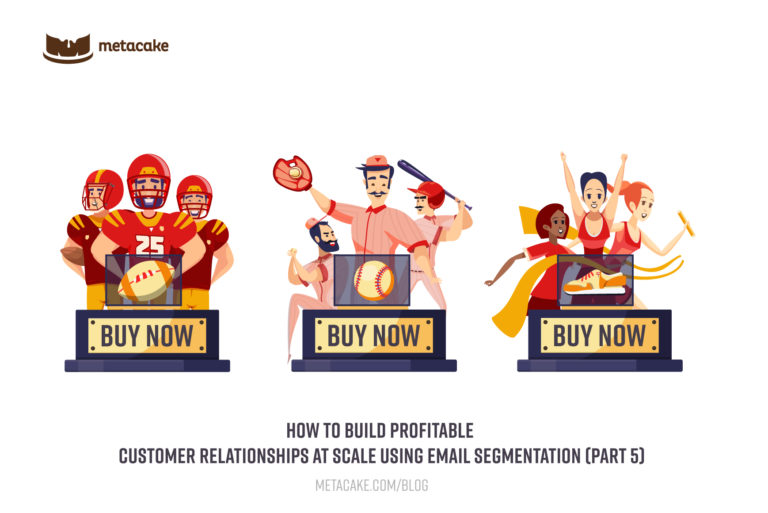If you’ve been following along on our journey to creating a powerful email program, there is one important component left: your audience. This is the third and final pillar of creating an ultimate email program for your ecommerce business. If you’re just joining us, you can start at part one of our series for the full context. If you’re currently sending emails to one massive list, pay attention to what’s coming. Segmentation will take your email program to the next level and significantly increase all key metrics!
What is Email Segmentation?
By definition, audience segmentation involves separating groups of customers based on certain actions or attributes that they have in common in order to communicate with them on a more personal level— and still do it at scale. As a rule, the more granular and tailored you can be with your emails to individuals, the more effective they will be at producing a result. For example, you will want to talk to customers that have abandoned their cart differently than customers who actually purchased a particular product last week.
In the past, sorting customers by behavior has been a difficult, manual process. It required downloading spreadsheets, creating pivot tables, then uploading hundreds of lists to your email platform. At best it was slow and inaccurate. However, when you use a modern email platform designed for ecommerce, it will collect and store all of this data from your ecommerce store automatically. This means you will be able to create segments quickly and easily on the fly. The ease of segmentation is very dependent on which email platform you choose, but Klaviyo makes it extremely simple and powerful. That’s probably the biggest advantage to using them.
The Importance of Segmentation
Just how powerful is segmentation? Imagine you want to build a relationship with a customer so that they will eventually purchase from your new line of skincare. How effective would you be if you knew nothing about their skincare needs, what products they’re interested in, what products they’ve purchased or how many purchases they have made with you? It would all be a guessing game.
Segmentation takes the guesswork out of who you are marketing and speaking to, allowing you to have conversations based on real data at scale. This means you could send different emails to customers depending on whether they are brand new to your company, just purchased for the first time last month, or have ordered your top-selling product every 60 days for the past year. These are vastly different relational levels and effective communication can only happen if you can speak differently to these groups. Now, these are simple examples, but the possibilities are endless. The more creative you are for your brand, the more effective segmentation can get!
How to Build a Segmentation Strategy that Drives Revenue
If you’re just getting started with an audience segmentation strategy, start simple and then grow more complex over time. Here is our step-by-step process on how to build your program:
1. Define Your Group
Begin by thinking about your top groups of customers based on behaviors they have exhibited in your store. We’ll provide several examples of these groups in the next section.
Pro Tip: Always create a segment with an end goal in mind. Create segments based on need— which groups of customers you need to talk to most. If you just create segments because you can, you won’t have anything of value to say to them.
2. Define Your Goal for This Group
To be effective you must have a goal in mind that you are trying to achieve with the emails you send. For each group, decide whether your goal is to simply to build a relationship with the customer through content, to sell to them, or both. This is highly dependent on the mindframe the customer in this group is in (pre-purchase, mid-purchase, post-purchase).
3. Create the Content
Decide what specific content and offers are relevant for each segment. This content can be delivered through automated sequences, but that’s not the only option. You can use segments as an audience for promotions or one-off email campaigns as well.
4. Distribute Your Message
There is power in a unified message on multiple platforms. This used to be hard or impossible, but with the right tools this can be done. Sync audience segments with other marketing channels. For example, Klaviyo has a Facebook integration that you can use to sync your segments as a custom audience in Facebook Ads Manager. This allows you to run Facebook ads to your customers with messages similar to your email campaigns. You can also use this custom Facebook audience to create a lookalike audience, which will allow you to target new visitors who have similar characteristics as your existing customers. This is about as powerful as you can get with new customer acquisition!
5. Identify Top Performers
Once you have sent automations, content, or promos to different segments, gather the email data and take a look at your best performing segments. Your most profitable groups are strong indicators for you as you are identifying your brand fans.
Your goal should be to identify the 10% of customers that are your super fans and feed them and use them to grow the business.
Pro Tip: As you set up segments, use a standard naming convention to help track and organize your audiences groups. As you create more and more segments, you’ll be thankful for an easy way to find and monitor these lists.
Important Audience Segments for Ecommerce
The audience segments you create and how they are defined will largely depend on the nature of your unique business. However, here is a core list of segments we recommend setting up for almost every brand.
1. Purchasers from a product group or collection
One way to segment your customers is by what they have purchased, separated out by product type, collection, style, gender, or other differentiators. This provides an opportunity to further educate customers on their purchase, as well as cross-sell additional products that are relevant for them. You could also provide a coupon or other offer to share with friends and family; they probably know more people like themselves who would enjoy your products.
One of our clients, GrooveLife silicone rings, used segmentation to speak specifically to customers who had purchased from their Women’s Aspire collection. Rather than email their entire list, they were able to send this survey about future products only to the group that cared about Aspire rings the most.

2. Specific products added to cart
Most brands have identified their Add to Cart (or Abandon Cart) segment. But have you considered getting even more specific with those abandoned cart notifications? Try segmenting audiences by specific products or collections they have added to cart. Then, instead of a standard “Come back to checkout” message for all products, attack potential objections to these products in a more personalized way. You could also give more specific discounts for different products if it makes sense for your brand.
Take a look at these engagement metrics for one of our clients’ Add to Cart segments. This looks at engagement for just the first email in a sequence of 5 emails after a customer abandons checkout. Open rate is 2-3x higher than their account average, and click through rate is over 4x higher!

3. VIP Customers
Without a doubt these are your most valuable customers. If you have yet to identify your VIP segment, you are missing out! This group is comprised of your top customers and (potentially) your biggest fans, which is full of opportunity. A few ways you can communicate with this group include:
- For new product releases, these fans will become your launch crew. Pre-sell products exclusively to this segment and encourage them to spread the word about how much they love it. This way, the rest of your audience will be eager to purchase when launch day arrives.
- Send exclusive rewards such as early access to special sales, exclusive discounts, or opportunity to test new products.
- Ask for feedback on what they would like to see next. It’s typically more effective to survey this focused segment because they are more likely to give a thoughtful response than your entire list.
As an example, one of our clients defines their VIP Customers as those who have purchased five or more times in the last year. Notice how high this segment’s engagement metrics are below, including a 56% open rate and almost 8% click through rate. This is about 2x higher than their average open rate and about 4x higher than average click through rate.
*Note that this is just one example; how you choose to define your own VIP segment depends on your brand, average order value, and customer lifetime value.

4. Customer Service for Particular Products
Another way to use segments around purchasers of certain products is for customer service follow up. If you happen to have a product recall or other issues with certain products, this is an easy way to stay in touch with the appropriate customers. You can also use this segment to notify customers when a product they have purchased has a new and improved version releasing.
5. Recent Purchasers
Be sure to create a segment of recent purchasers— those who have bought in the last two weeks— to have on hand as well. This is a practical segment that’s helpful for lessening customer service issues while running a sale. When announcing a promotion, it’s often helpful to exclude these recent purchasers from the email campaigns to avoid customer complaints, returns, or buybacks.
As an example, GrooveLife experienced an issue with product quality in their first round of camo rings. As a brand known for their superior quality, this was completely abnormal and they needed a way to address the problem with only the customers who purchased that product. They chose to place all camo ring buyers in one segment and be completely honest with them through email, promising to make it right as soon as possible. The engagement metrics on this simple email were through the roof and their honesty with this group actually created insanely loyal fans. What was a problem became a massive opportunity.

6. Unengaged List
Another important segment are the people who are showing little to no activity. We refer to this group as your unengaged list, which can have a variety of definitions. You could look at customers who have not purchased from you in the past year, names who have not opened an email in the last 3 months, or those who open emails but never click. We recommend two steps with these names that have gone dark:
First, exclude this segment from your weekly (or regular) email communication. If it’s a significant number of names, they are likely throwing off your engagement metrics (open and click through rates) on these emails. You may feel uncomfortable watching the number of names you’re sending to drop, but quality over quantity holds true here.
Second, try to win this segment back. Let them know they are missed, send a coupon offer, or update them on the awesome products that have come out since they last purchased. Be sure to A/B test multiple subject lines, especially if you’re sending to those who haven’t opened in several months. Be as creative as possible to hook their attention. If after a few win-back attempts this list is still dark, it’s not the end of the world! Move those ghosts to a new segment and continue to exclude them from regular emails.
Keep the End Goal in Sight
Let’s not lose sight of why we take the time to strategically build these segments of customers. As we discuss so often, it’s all about creating fans of your brand. The goal is to use your ecommerce data (which is hopefully integrated with your email service provider) to learn about your customers and speak to them accordingly. This is the only way to truly build relationships and trust with your customers. As you do so, you will grow a stronger business, deliver more valuable products, and ultimately create loyal brand fans for life!
We still have one more final part on our guide to creating an email program that dominates fro your ecommerce business. Want to know when it comes out? Sign up for our Growth Academy Newsletter.
